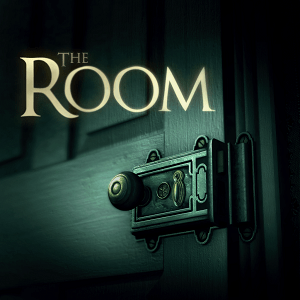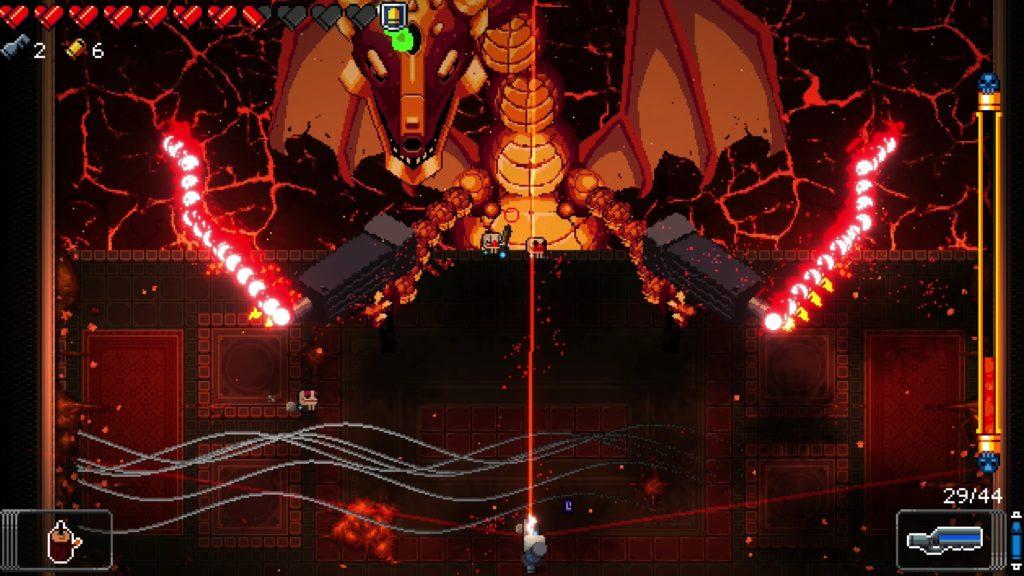For this week’s critical play, I played Fireproof Games’ The Room, developed for the iPad (but also available on PC and Android). While playing, I entered a tactile world of many intricately decorated and designed boxes, many cryptic symbols and glowing runes, and a lot of mysteries that unraveled layer by layer. Although other puzzle games sometimes separate mechanics from narrative, The Room fuses mechanics and narrative through atmospheric design and user interaction choices. The touchscreen interface means that every rotation of a key or flick of the lighter mimics real-world movements and gestures, anchoring these more abstract puzzles in physical reality. Through spatial metaphors, tactile interactivity, and symbolic visuals, The Room elevates puzzle games by embedding mechanics in physical space and narrative scaffolding. Isolated logic exercises are imbued with emotion and moments of discovery. The developers’ design choices empower players to feel not only like problem-solvers, but also like explorers uncovering forbidden knowledge.
The Room gameplay mechanics are centered around beautifully decorated and designed puzzle boxes—objects that invite interaction while limiting exploration. Each box is like a metaphor that the knowledge the player seeks is hidden and contained within layers, and can only be accessible through gaining key insights and manipulation. I really enjoyed the touch based nature of the game and being able to shift my perspective of the box by dragging and tapping to zoom in. From a design perspective, this makes the interface more intuitive and creates the fun of discovery for the player. But also from a narrative standpoint, it adds to the agency of the player as they are trusted with the knowledge to explore and uncover treasured hidden truths. A key design element of each box/safe is that there is no clear entry point. At times this made me feel a bit helpless, because I would just circle around the box multiple times without any clue as to what I should do. However, this did contribute to my sense of curiosity and determination because I knew that I had the information I needed, and I was trusted by the gamemakers to be able to experiment and decode the clues, albeit slowly.
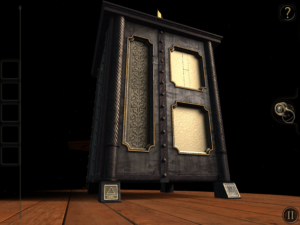
The first puzzle box that I encountered!
A big mechanic and visual cue used to create the puzzles of the game was introduced by way of an eyepiece that gives the players “sight” (otherwise they would be “as blind as the rest of them”). Viewing through the lens shows illuminated symbols and graphs, a clear shift in perception.
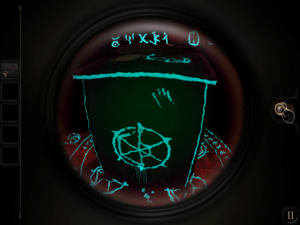
Runes and symbols that were revealed on the puzzle box by using the lens
While developers could have chosen to hide codes behind panels, they give the player a tool that reframes their visual relationship to the world, reinforcing the idea of thinking in layers to solve the puzzles. The more supernatural nature of these symbols also allows for visuals like “floating numbers” which opens the door for perception manipulation puzzles (e.g. shifting perspective to line up floating pieces to see numbers). The game designers, through this mechanic, expand the player’s ability to explore and think in layers, while also contributing to the immersive nature of the mystical atmosphere of the game.
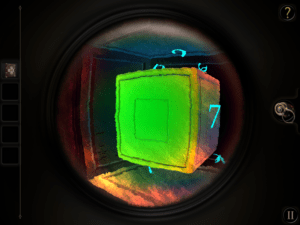
Perception Puzzle to create floating numbers
Next, to reflect on some ethical design considerations of the game, while The Room minimizes language-based barriers by offering its game in different languages (e.g. French, Italian, German, Spanish, and Brazilian Portuguese), its game is inaccessible to those that do not speak these languages (for example Chinese speakers). But more than that, its visuals and mechanics assume that the player knows certain information. Developers assume that players know how to use tools like a key, a lighter (specifically the ignition button that you roll down), or how to switch numbers on a dial lock. From a game designer perspective, it makes sense not to point out things like “This is a lighter and this is how you use the ignite button” and instead say “Something smells burnt here….” because it gives the players more room for discovery fun and a sense of achievement when they figure out what the clue wants them to do. The game also opens with a riddle saying “Feed me and I thrive but give me water and I die” which is meant to direct you to the “Fire” symbol on the leg of the table. The use of these abstract riddles presupposes a degree of educational background that has exposed players to this sort of ambiguous and high level “out of the box” thinking. Overall, The Room is able to create a richly symbolic environment for speakers of primarily Western languages and those familiar with specific tools and methods of higher level thinking, but inadvertently excludes players who lack familiarity with these certain conventions. So while assuming players have certain knowledge can make the gameplay and fun of discovery more rewarding for players that do actually have that knowledge, it detracts from the experience of those who don’t.
Overall, I thoroughly enjoyed my play of The Room and felt very immersed into the setting with the eerie music and beautiful graphic visuals. The game effectively meets its goals of giving trust and agency to players to break down the multi-layered puzzle boxes, creating a sense of fun in discovery, while immersing players in a mystical atmosphere.


